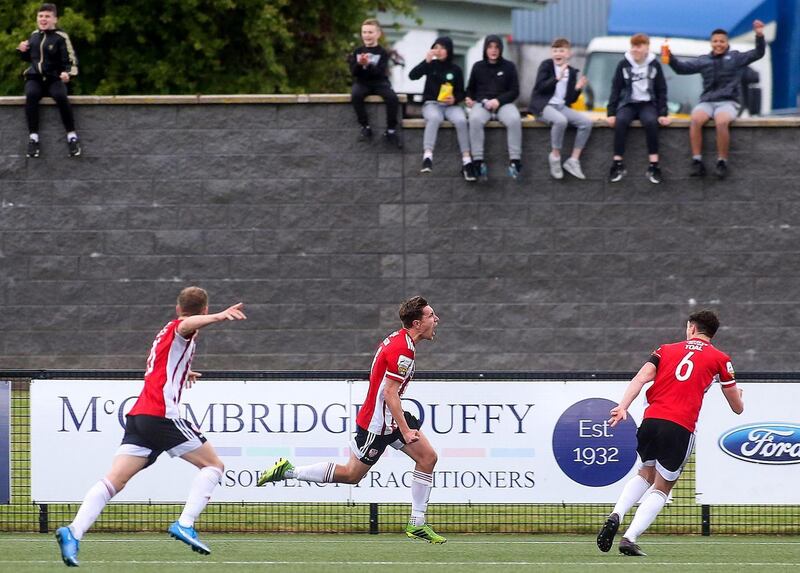Fans of Derry City FC had been looking forward to getting back in the stands for the first time since Christmas.
A successful test event at the Irish Cup final in Lurgan on May 21st – attended by 1,000 people – paved the way for the easing of Covid-19 restrictions in the North, with up to 500 spectators now allowed to attend outdoor sporting events.
But two weeks ago, the club took the decision not to allow supporters attend their home match against St Patrick’s Athletic.

This was on the recommendation of the North's Public Health Agency (PHA), the club explained, due to high rates of Covid-19 transmission in the city.
The move was typical of the type of targeted action that is being taken by health authorities and local councils on both sides of the Border to try to bring down the rate of infection in the northwest.
An enhanced planning process has been implemented, says Dr Stephen Bergin, interim director of public health with the PHA. "We have had weekly engagement anyway . . . but we formalised that a bit in response to this persistent level within that area."
The approach is to work together on measures such as targeted testing facilities and enhanced public health messaging, says Dr David Cromie, health protection consultant with the PHA.
For example, “if we have identified businesses where there are increased cases, we want to intensify those measures so that will be to do with reducing footfall, or [increasing] ventilation, or making sure that there is separation for staff and for people coming in.
“This is about a whole plethora of measures that are required to put downward pressure on cases.”

Worst-affected areas
On the Northern Irish side of the Border, this targeted approach is bearing fruit. Since autumn the northwest has been regularly in the headlines as one of the areas worst-affected by Covid-19.
During the first wave, rates were relatively low – indeed Derry and Strabane were among the lowest in Northern Ireland – but this changed rapidly as the summer ended; by October the rate of infection on Derry's Cityside was the worst on these islands – if not farther afield – at more than 1,000 cases per 100,000 people.
Measured against that benchmark, the region is clearly in a much better place. According to Friday's figures from the Department of Health in Northern Ireland, there were 45.8 cases per 100,000 people over the past seven days in Derry and Strabane – still the highest in the North, and more than three times higher than the Northern Irish average of 25.2 – but, importantly, lower than they were a week ago.
According to the interim 14-day report released by the HSE's Health Protection Surveillance Centre on Friday, the rate per 100,000 in Donegal stands at 181.5 – second only to Limerick.
In Northern Ireland, a long, hard lockdown and the impact of the vaccination programme have improved the situation to the point where the rules have been significantly relaxed and indoor hospitality and the tourist industry have reopened.
The Republic is catching up – outdoor hospitality reopens on Monday – and indoor hospitality is set to reopen in July – but in the short term, the North remains ahead.
As for vaccinations, more than 70 per cent of the adult population of Northern Ireland have received a first dose of the vaccine, and the scheme is now open to everyone over 18. In the Republic, the attack on the HSE’s IT systems means recent data is not available, but the Taoiseach predicted 50 per cent of adults would have had their first jab as of last week.
Facilitating spread
In the context of the northwest, this difference in vaccination rate in a relatively small geographical area could facilitate the spread of the virus, says Dr Andrew Kunzmann, an epidemiologist from the centre for public health at Queen's University Belfast.
"Some of the incidence [of the virus] will be because there is that close link and people in Derry are coming into contact with more people who are less vaccinated than perhaps somebody in Belfast. "
In the context of Derry, Strabane and Donegal, such contact is inevitable. “The city doesn’t really stop at the Border, it keeps going on another 20 miles, a bit like Greater London.
“Unlike the sort of M1 corridor, where there’s a lot of industrial travel up and down, two-thirds of the road count is just people like you and me going to work, so it’s like one big city,” says Dr Bergin.
"If you go down below that, Lifford and Strabane are across each side of the river, the big Asda [store] is in Strabane and everybody comes across.
“That needs to be conceptualised in respect of the geography, and that probably explains at least half of the answer here.”
The implications of socialising and family events – the First Communions, the Confirmations, the birthday parties – have been well documented in the northwest. Anecdotally there are indications that the recent relaxing of the rules in Northern Ireland has led to an increase in non-essential cross-Border travel.
“The more mixing there is, the more chance there will be of spread, and the more occurrence of cases at the time will also generate the spread,” says Dr Cromie.
“These are not very distinct populations as such, and people do move around, and the plea from the public health point of view is essentially that there are cases, and high levels of cases, in this area and the ask would be that people restrict their activities as much as possible to restrict the spread and also to get the vaccine as soon as it becomes available to them.”
Situation in flux
Much is in flux, as Dr Kunzmann points out. While the Republic’s vaccination programme is catching up, the consequences of the recent easing of restrictions in the North remain to be fully seen.
“This stage of reopening will put more pressure on transmission, and even the rollout here [in Northern Ireland] may not be quite enough yet to hinder that transmission and stop that transmission happening.
“The next few weeks are crucial, I think, and that travel may put that extra pressure on transmission on both sides of the Border.
“There could be a situation where cases rise fairly quickly in Derry over the next few weeks, which could then put extra pressure on transmission in Donegal.”














